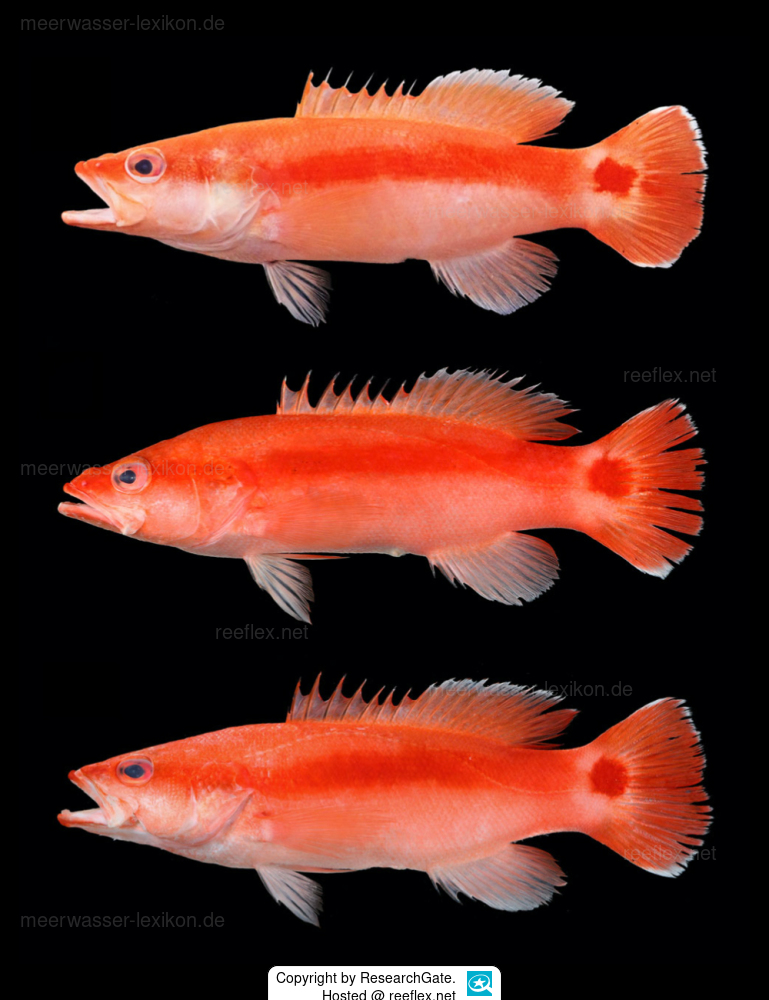Info
Liopropoma terecaudum
Liopropoma terecaudum sp. nov. is described based on 12 specimens collected off northern Taiwan.
The new species most closely resembles two sympatric species, Liopropoma japonicum and Liopropoma dorsolutum, but differs from both of them and from all other species of the genus Liopropoma by the following combination of morphological and color characteristics: round caudal fin, dorsal fin elements VIII, 13 without distinct notch, broad red lateral stripes along the body, and a large red spot at the base of the caudal fin.
A phylogenetic analysis of mitochondrial DNA barcode sequences places L. terecaudum in a clade with Liopropoma dorsolutum and Liopropoma japonicum. The average genetic divergence between L. terecaudum and Liopropoma dorsolutum and between L. terecaudum and Liopropoma japonicum is 11.8% and 11.9%, respectively.
The description of L. terecaudum increases the total number of Liopropoma species in Taiwanese waters to 11.
Fish of the genus Liopropoma Gill, 1861 are small to medium-sized (up to approx. 270 mm standard length) perch-like fish that are distributed worldwide in tropical and subtropical waters (Randall & Taylor, 1988). While some Liopropoma species are cryptic and live in shallow waters, most species typically inhabit deep reefs in the mesophotic and rariphotic zones (Baldwin & Robertson, 2014; Koeda et al., 2019). Advances in collection methods for deep reefs, such as manned submersibles and rebreather diving, have led to the discovery and description of three new Liopropoma species in the last decade, bringing the number of valid species to 32 (Baldwin & Johnson, 2014; Baldwin & Robertson, 2014; Pinheiro et al., 2019). Nine of these are distributed in the Atlantic Ocean, while the remaining species occur in the vast Indo-Pacific region (Pinheiro et al., 2019).
In their latest review of the genus, Randall & Taylor (1988) synonymized Chorististium Gill, 1861, Pikea Steindachner, 1875 (including the subgenus Labracopsis Steindachner & Döderlein, 1883), Ypsigramma Schultz et al., 1953, and Flagelloserranus Kotthaus, 1970 under Liopropoma. They diagnosed Liopropoma based on the following combination of characteristics: moderately elongated body; pointed snout; bony hook-shaped process on the ventral-posterior upper jaw; continuous or “divided” (i.e., deeply incised) dorsal fin with VIII, 11–14 rays; anal fin elements III, 8–11; villiform teeth without fangs; weakly ctenoid scales; and a complete lateral line with 44–66 perforated scales.
Baldwin and Johnson (1993) hypothesized about the phylogenetic relationships of the Epinephelinae (now Epinephelidae, see Near & Thacker, 2024) based on cladistic analyses. They proposed three synapomorphies for the Liopropomini (= Liopropominae, including Liopropoma).
Keeping in aquariums:
Most smaller Liopropoma live very hidden in caves and crevices. Therefore, a similar rock and reef structure should be provided. In aquariums with HQI lighting, they avoid the open swimming zone.
This colorful fish is an absolute asset to the community aquarium and does not seem difficult to keep. Corals are left alone.
This is a rare fish about which little is known.
Description of a new liopropomine basslet, Liopropoma terecaudum, from northern Taiwan (Perciformes: Epinephelidae)
Liopropoma terecaudum sp. nov. is described based on 12 specimens collected off northern Taiwan.
The new species most closely resembles two sympatric species, Liopropoma japonicum and Liopropoma dorsolutum, but differs from both of them and from all other species of the genus Liopropoma by the following combination of morphological and color characteristics: round caudal fin, dorsal fin elements VIII, 13 without distinct notch, broad red lateral stripes along the body, and a large red spot at the base of the caudal fin.
A phylogenetic analysis of mitochondrial DNA barcode sequences places L. terecaudum in a clade with Liopropoma dorsolutum and Liopropoma japonicum. The average genetic divergence between L. terecaudum and Liopropoma dorsolutum and between L. terecaudum and Liopropoma japonicum is 11.8% and 11.9%, respectively.
The description of L. terecaudum increases the total number of Liopropoma species in Taiwanese waters to 11.
Fish of the genus Liopropoma Gill, 1861 are small to medium-sized (up to approx. 270 mm standard length) perch-like fish that are distributed worldwide in tropical and subtropical waters (Randall & Taylor, 1988). While some Liopropoma species are cryptic and live in shallow waters, most species typically inhabit deep reefs in the mesophotic and rariphotic zones (Baldwin & Robertson, 2014; Koeda et al., 2019). Advances in collection methods for deep reefs, such as manned submersibles and rebreather diving, have led to the discovery and description of three new Liopropoma species in the last decade, bringing the number of valid species to 32 (Baldwin & Johnson, 2014; Baldwin & Robertson, 2014; Pinheiro et al., 2019). Nine of these are distributed in the Atlantic Ocean, while the remaining species occur in the vast Indo-Pacific region (Pinheiro et al., 2019).
In their latest review of the genus, Randall & Taylor (1988) synonymized Chorististium Gill, 1861, Pikea Steindachner, 1875 (including the subgenus Labracopsis Steindachner & Döderlein, 1883), Ypsigramma Schultz et al., 1953, and Flagelloserranus Kotthaus, 1970 under Liopropoma. They diagnosed Liopropoma based on the following combination of characteristics: moderately elongated body; pointed snout; bony hook-shaped process on the ventral-posterior upper jaw; continuous or “divided” (i.e., deeply incised) dorsal fin with VIII, 11–14 rays; anal fin elements III, 8–11; villiform teeth without fangs; weakly ctenoid scales; and a complete lateral line with 44–66 perforated scales.
Baldwin and Johnson (1993) hypothesized about the phylogenetic relationships of the Epinephelinae (now Epinephelidae, see Near & Thacker, 2024) based on cladistic analyses. They proposed three synapomorphies for the Liopropomini (= Liopropominae, including Liopropoma).
Keeping in aquariums:
Most smaller Liopropoma live very hidden in caves and crevices. Therefore, a similar rock and reef structure should be provided. In aquariums with HQI lighting, they avoid the open swimming zone.
This colorful fish is an absolute asset to the community aquarium and does not seem difficult to keep. Corals are left alone.
This is a rare fish about which little is known.
Description of a new liopropomine basslet, Liopropoma terecaudum, from northern Taiwan (Perciformes: Epinephelidae)







 ResearchGate
ResearchGate































